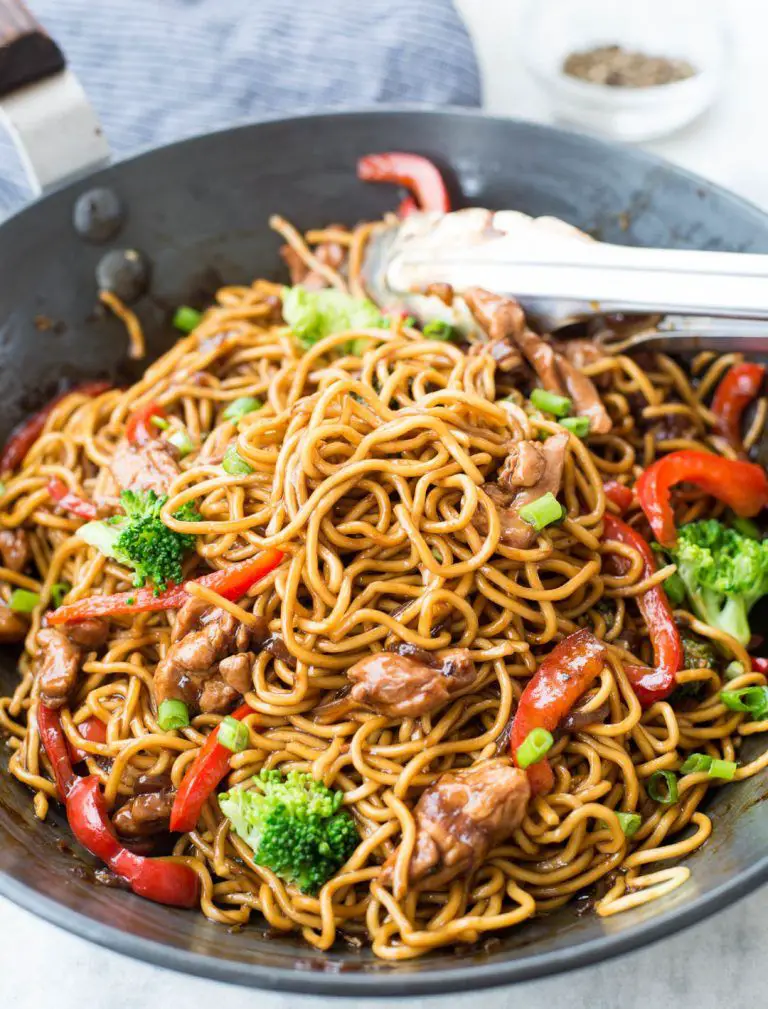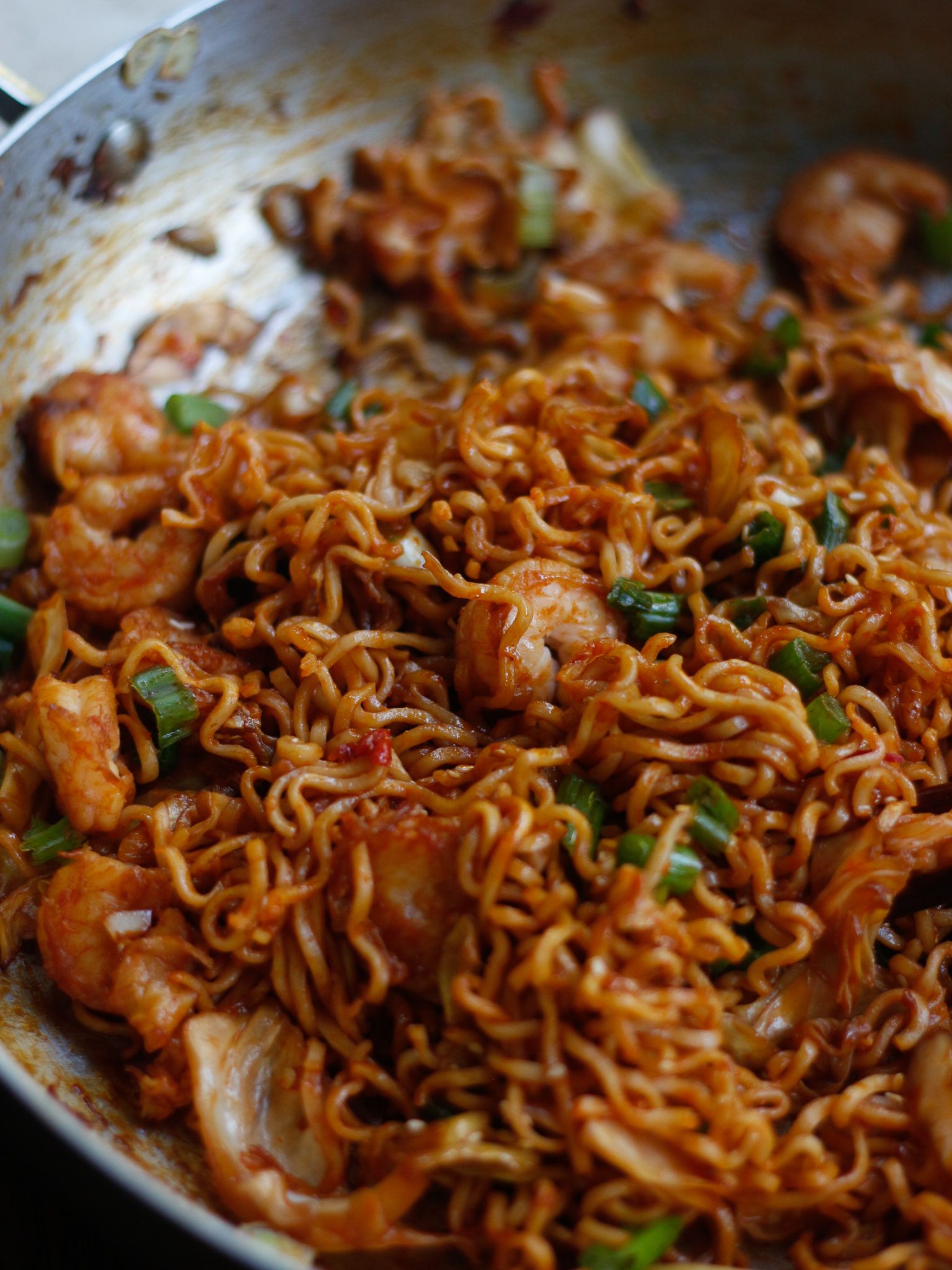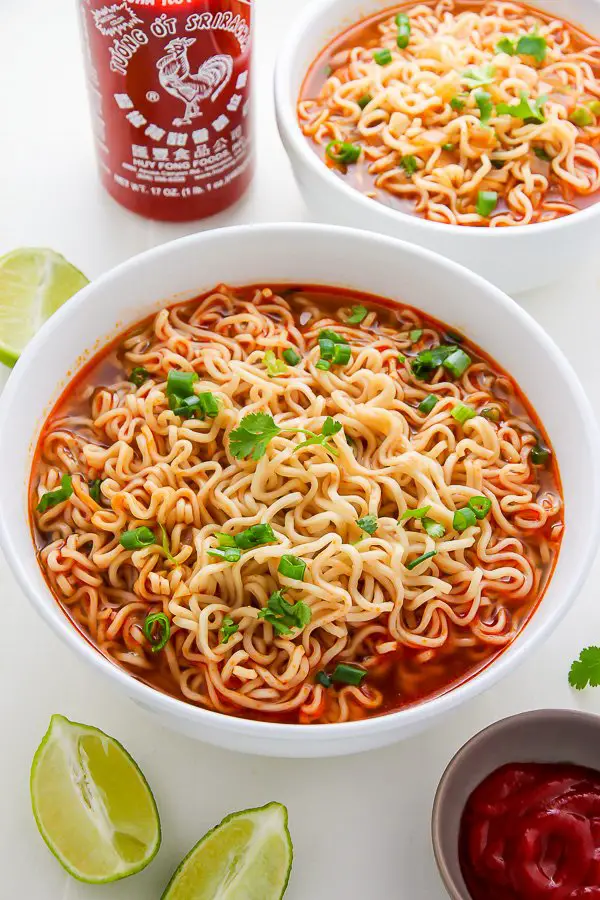Preparing And Cooking The Noodles
Tips for chewy noodles:
- Since well be cooking down the noodles in the sauce later on, I like to slightly undercook my noodles.
- You can cook your noodles around 2 minutes less than the package instructions or until they still have a good bite.
- You can opt to run them through water after cooking to help stop the cooking but I like to add them directly to the sauce from cooking since this way the noodles can better absorb the flavours.
- If youd like to add the noodles directly to the sauce, I suggest preparing everything beforehand and make sure the sauce is ready in the pan before you cook the noodles.
Homemade Chili Chicken Ramen
ramen tastes best when itâs fresh from the kitchen. our kitchen, your kitchen. we donât mind. wherever itâs made it leaves you and your friends full of the feel good. thatâs why we want to share a recipe for soul warming chili chicken ramen. so you can try to make it yourself. and if you tell people itâs your own recipe. we wonât tell a soul
What Is Tiktok Ramen
Tiktok ramen is where you use instant ramen noodles, ditch the seasoning packet, and make your own sauce. Unlike soup-y ramen, Tiktok ramen is a soup-less ramen, kind of like mazemen or sesame noodles. Ramen noodles are tossed in a garlic butter soy brown sugar sauce, cooked with an egg and finished with a sprinkle of everything bagel seasoning.
Don’t Miss: How To Make Bourbon Sauce
These Saucy Ramen Noodles Are:
- Coated in a thick & tasty sauce. You easily adjust the seasoning and flavours to your liking!
- Easy to make. Youll only need a few basic ingredients and 20 minutes or less!
- Versatile. You can easily add whatever vegetables and protein of your choice to these noodles.
These noodles have also become a staple for those really busy days because of how easy it is to put it together. Youll only need 20 minutes or even less to prepare these noodles!
Add Fresh Or Frozen Veggies To Make A Homemade Ramen Soup

Toward the end of the boiling process, add some leafy greens like spinach, bok choy, or cabbage to the broth. The veggies should wilt in the boiling water with the ramen, so you won’t have to use a second pot.
You can also run some frozen veggies under running water until they defrost and then toss them in the pot when the noodles are almost done cooking.
Read Also: Shrimp Alfredo Pasta With Prego Sauce
Are You Looking For More Delicious Vegan Recipes
You can get a copy of my upcoming cookbook, Vegan Asian!
If you crave vegan-friendly versions of classic Asian dishes, this cookbook is packed with Southeast and East Asian dishes inspired by those I grew up enjoying at home and those Ive tried from my travels. From iconic Thai dishes to piping-hot Japanese fare and everything in between, the recipes in this will take your palate on a delicious food trip across Asia, and hopefully keep you coming back for more!
Why Are Chicken Carcasses Used
Well, it is because Chicken carcasses contain a large amount of one of the Umami components glutamic acid. So this becomes the basis of the ramen soup flavor. Also, chicken feet, known as Momiji, are often used. However, it is a little difficult to get these so I substitute them with chicken wings.
Adding a little bit of meat on those chicken wings will add sweetness and deep rich flavor to the broth without turbidity. Chicken wings are readily available and quite cheap from supermarkets. I get Chicken carcasses from local butchers. It is also cheap. I got 4 of them for A$2
Also Check: All Clad Stainless 3 Qt Sauce Pan
Can I Add Other Ingredients
Yep. You sure can! I love to cook and I have a zillion cookbooks that I adore, but I still rarely follow any recipe as written.
Want to make it spicier? Add some paprika or cayenne pepper to your spice mix. Heck, you can even add some Franks Red Hot Sauce to your noodles after theyre done cooking.
Use common sense and dont add anything weird and you should be totally fine!
Bon appetit!
Why Youll Love These Ramen Noodles
- Youll love that you can use ramen noodles in a different way other than just cooking them up in some soup!
- This recipe is quick and easy to make, so its perfect for those busy weeknights when you dont have a lot of time to make dinner.
- This stir fry can be modified in any way you like! You can add your favourite toppings like fried onions, cilantro or crushed peanuts, or add in some other veggies or even some tofu!
Recommended Reading: Campbell’s Creamy Garlic Butter Chicken Oven Sauce
This Post Has 41 Comments
This is super delicious!! Im a very active ramen eater and maker and I try out different recipes every week. This recipe is one of the best ones! Its a fast and simple recipe with a flavor punch. I used arrowroot powder as a substitute for corn starch as I cant have corn starch and it worked perfectly!
Hi Hannah! Wow thank you so much and really happy to hear you enjoyed these . Appreciate you leaving a review too
Ooooooo my god you guys HAVE to make this recipe. I added some leftover roasted cauliflower from last nights dinner and Im absolutely in love with the results.
Thanks so much Sasha!! Really happy you enjoyed it!!
This is amazing. Thank you for this recipe. It comes in really handy as a busy uni student.
Youre most welcome, Olga!!! Hope you enjoyed it!
Needed something quick for dinner and this was perfect! I added some veggies I had on hand to round out the meal.
Hi Jackie! Thanks so much for pointing this out. I just checked and print version of the recipe is still the old recipe so Im not sure why it hasnt synced. Appreciate the feedback too.
This was sooooo good and super easy to make and a good use of leftover veggies in the fridge!
Thanks so much Felicia, glad you liked it!!
Thanks karen!!
What Sauce Is Good With Ramen Noodles
Were really into this simple sesame-garlic saucedinner just doesnt get yummier or easier than this. In essence, its a very basic stir-fried noodle recipeno veggies or meat, even! Just ramen noodles, stir-fried in a yummy sauce. Heres whats in our delicious garlic ramen stir-fry sauce:
- Soy sauce
- Chili sauce, like sambal oelek or sriracha
- Garlic
- Ginger
Also Check: How To Remove Bbq Sauce Stain
How To Cut Down The Cooking Time When Making This Easy Chicken Ramen Recipe
This homemade chicken ramen recipe takes about 45 minutes because I cook the chicken separately. I also prefer to cook the ramen separately as well. But here are some ways to make this recipe even faster, and cut it down to 25 30 minutes!
So there you have it. This homemade ramen is nothing if not flavor-packed! I hope you guys love this chicken ramen recipe just as much as we do! If you are a fan of noodle recipes, then this delicious ramen is a must try!
If you liked this recipe, you may also like,
The Right Bones To Use For Tonkotsu Ramen Broth

Having been trained in classical Western kitchens, my first instinct when making a broth is to keep it as clean as possible. Perfect clarity is the goal. As Michael Ruhlman puts it, you want to be able to read the date on a penny at the bottom of a pot of good French stock. To achieve this, you boil your bones and aromatics as gently as possiblea sub-simmer, with the surface barely quiveringmeticulously straining the entire time to remove any impurities that might cloud your soup.
When making a Western-style stock, heating bones in water is a means of removing water-soluble proteins from the interior and exterior of the bones and dissolving them into solution, adding flavor to the water. The heating and simmering process also catalyzes a few other reactions, mainly the conversion of collagenthe protein that comprises most of the connective tissueinto gelatin, the familiar protein that thickens and adds richness to broth .
With tonkotsu broth, on the other hand, you go one step further. In this case, bones are cooked at a rolling boil for a long, long, long, long period of time. Not only does all the same dissolving and gelatin creation take place, but you also end up breaking down other matterfat, marrow, calcium, various other minerals and proteinsinto tiny tiny pieces which get suspended in the liquid, turning it opaque.
You May Like: Low Carb Sugar Free Bbq Sauce
Ways To Upgrade Instant Ramen
Confession time: sometimes I actually like instant ramen. You know, those cheap little packets of salty noodles that only cost 30¢? I dont eat them often, maybe once per year, but when I get the craving Im totally not above grabbing a packet of instant noodles and going to town. Over the years Ive found 6 easy ways to upgrade instant ramen, like to the point where it might actually qualify as a legit meal, AND use up the leftovers in my kitchen at the same time. So Im going to share them with you today because its a total win-win.
Originally published 12-16-2015, updated 4-25-2019.
Yeah, thats instant ramen in that bowl in the photo above. And those upgrades were pretty inexpensive.
Now its obvious that the best way to upgrade instant ramen is to just get real ramen , but thats not what were talking about today.
Were talking about when your only option, or your preferred option, is the inexpensive little ramen packets that you can find in just about any grocery or convenience store in America. So, when thats what youve got, heres what you can do!
Putting It All Together
- Broth: Ramen broth can be made up to a week in advance, and can also be made and frozen in single-serve portions for thawing and eating anytime. The broth should be brought back to a full boil before serving with the ramen.
- Seasoning: The flavorful tare mixture can be made up to a week in advance as well. As were using a simple mixture of soy sauce and mirin, this mixture can be made and kept on hand at all times . You can add this tare to a pot of stock or to single bowls of ramen broth just before serving.
- Noodles: The ramen noodles should be cooked in boiling water just before serving. Boiling the noodles in the broth can result in gummy noodles. Instead, cook the noodles separately in just water and drain before adding to the individual bowls of broth.
- Toppings: This style of ramen is often served with cooked pork on top, sometimes ground pork, roasted pork loin, or pork belly. Since we focused our efforts on making the best ramen broth possible, we chose to keep the toppings simple. A silky-soft boiled egg, some pickled bamboo, dried nori, and a drizzle of sesame oil is all that a bowl of this ramen needs to turn it into a meal.
Read more: 5 Expert Tips for Making the Perfect Bowl of Ramen
Also Check: Can I Have Cocktail Sauce On Keto
Adding Fat To Tonkotsu Ramen Broth
At this point, I could have thrown in the side-towel and called it a day. After all, many ramen-ya get along just fine with tonkotsu broth, flavorings, noodles, and toppings. But sorry, not good enough for me.
See, the best of the best, cream of the crop ramen-ya will add a final little flourish to push their bowls of soup over into top-ramen territory: finely chopped, super-tender pork fat.
To get it is simply a matter of adding a hunk or pork fatback directly to your pot as the bones cook. After the first four hours or so, you end up with fat that is almost liquid in texture but still manages to barely hold its shape, like the finest panna cotta.
I chopped this fat up into tiny bits then whisked some into the soup just before serving with a vigorous hand to break up the bits even further.
The fat is there, to be sureyou can see the little bits floating around on topbut it’s so tender that you don’t feel it on your tongue. Instead, you simply get an unparalleled feeling of rich meatiness. If you could convert the world’s juiciest, fattiest pork chop into slurpable, liquid form, that’s what you get with each bite of the fat-laced broth.
Faqs About Spicy Ramen Noodles
Recommended Reading: How To Make Raising Cane’s Sauce
How To Store The Broth
Although it is worth the effort to taste such robust flavourful ramen at home, we dont have time to make such long process broth. So I make it in batches and divide the broth into one use portion in a ziplock bag and freeze them. The broth will keep for a couple days in the fridge and about a month in the freezer.
Cooking The Sauce And Noodles Together
I simply heated a large non-stick pan and sautéed the tofu and mushrooms in some oil.
I then poured in the sauce and left it to simmer over medium heat. Itll slowly thicken from the starch.
Afterwards, I added the half-cooked ramen noodles into the sauce.
Mixed it all together to evenly coat in the sauce.
Cook for a few minutes or until the sauce thickens and beautifully coats the noodles.
Heres a really sauce close-up of those noodles ?
You May Like: Chicken Alfredo With Premade Sauce
How To Make Sesame Garlic Noodles
OK this sesame ramen noodle stir-fry really is about as easy as can be. If you can make instant ramen, you can make these saucy sesame garlic ramen noodles.
How To Make Each Tare

Shio Combine dashi , Sake, and Mirin in a saucepan over low heat. Add salt and resolve it.
Shoyu Convenient way to make Shoyu tare is to use the sauce that was used to make Chashu. After straining the sauce put it in a saucepan over low heat and reduce the amount to half. After it has cooled down, I usually divide the sauce into small portions and keep in the fridge/freezer for other uses.
Miso Blend all ingredients with a stick blender or food processor and add miso to combine. You can keep this in the fridge/freezer and use for other recipes such as Yaki Onigiri Grilled Rice Balls and stir fry.
Don’t Miss: How To Make Homemade Chicken Alfredo Sauce
Kombu Dried Shiitake Soy Sauce And Mirin
Ramen broth is much like any rich soup broth, in that it uses bones and aromatics to make a base for noodles and toppings. The most significant difference between ramen broth and plain stock is the two-part flavoring system. Kombu and dried shiitake mushrooms enhance the broth while it cooks, giving the broth an earthy taste unlike other broths.
The second addition to ramen broth is a system of flavoring known as tare. Tare is a mixture of intensely flavorful liquids or pastes that are added to the ramen broth just before serving. The most basic is a 50/50 mixture of soy sauce and mirin. Some are made with miso or include chili pastes.
For a restaurant-quality bowl of ramen anytime, keep kombu and dried shiitakes on hand for enhancing even homemade broth. Ditto for soy sauce and mirin. You may also want to keep pickled bamboo shoots and nori on hand for ramen enhancements.
